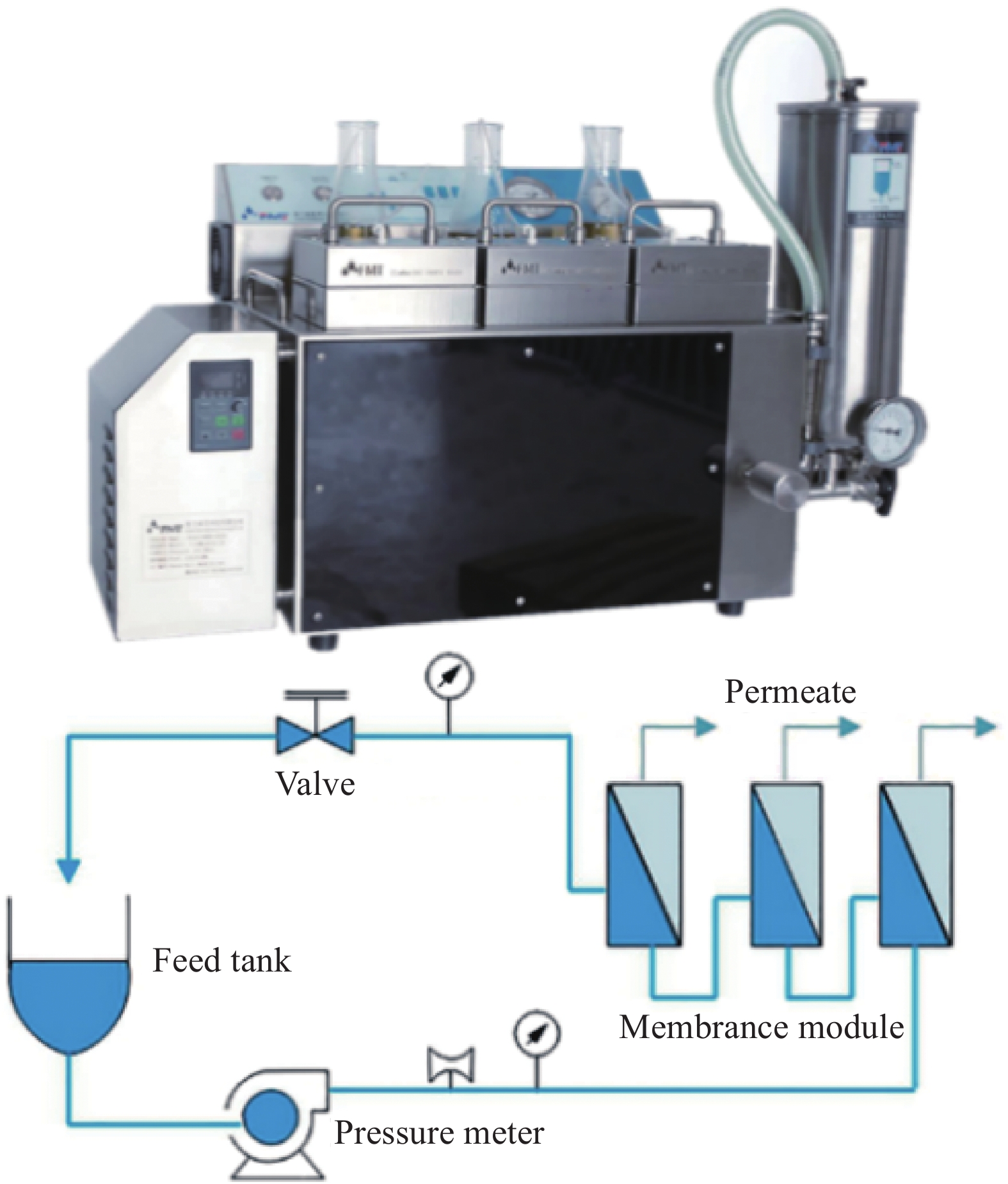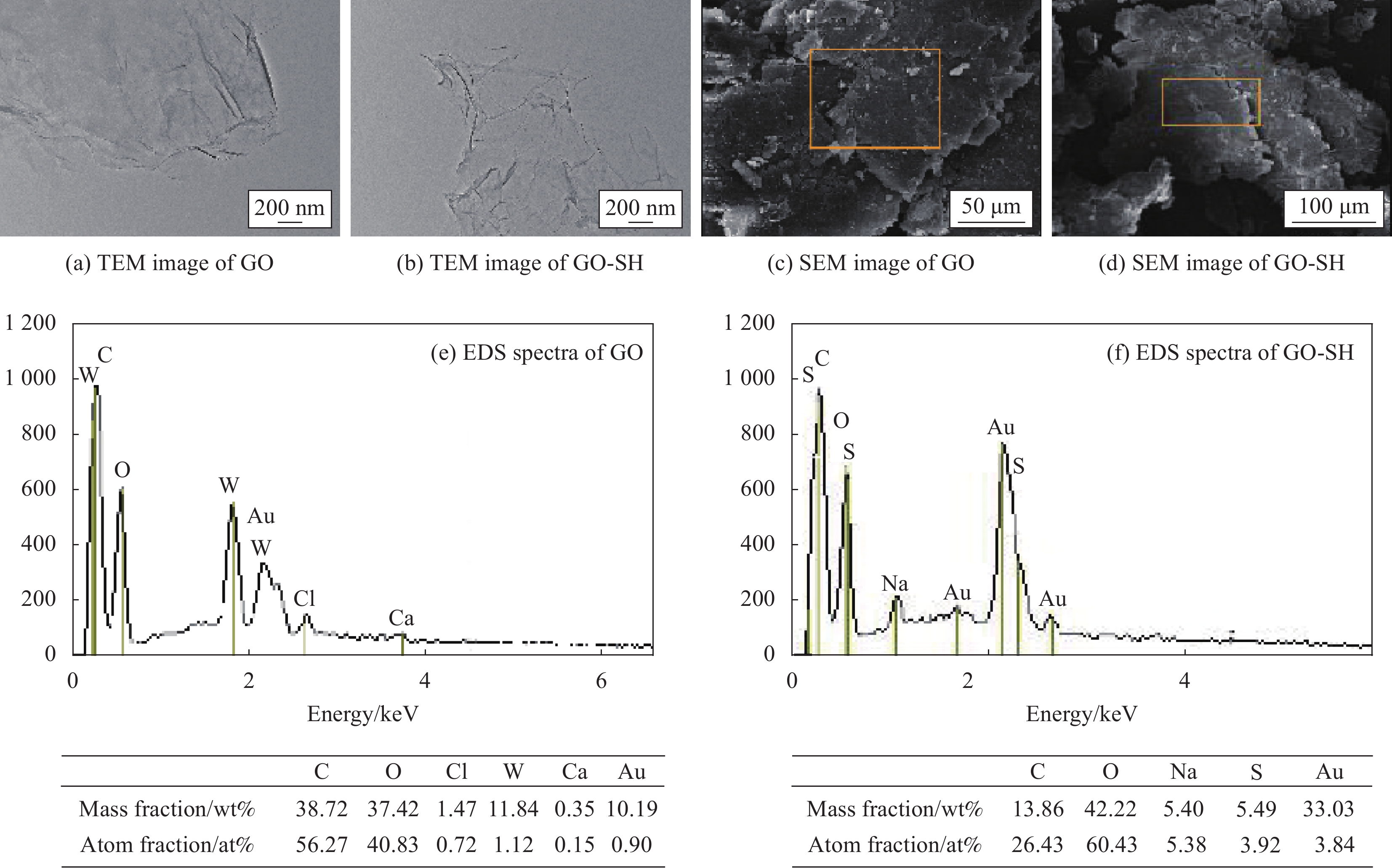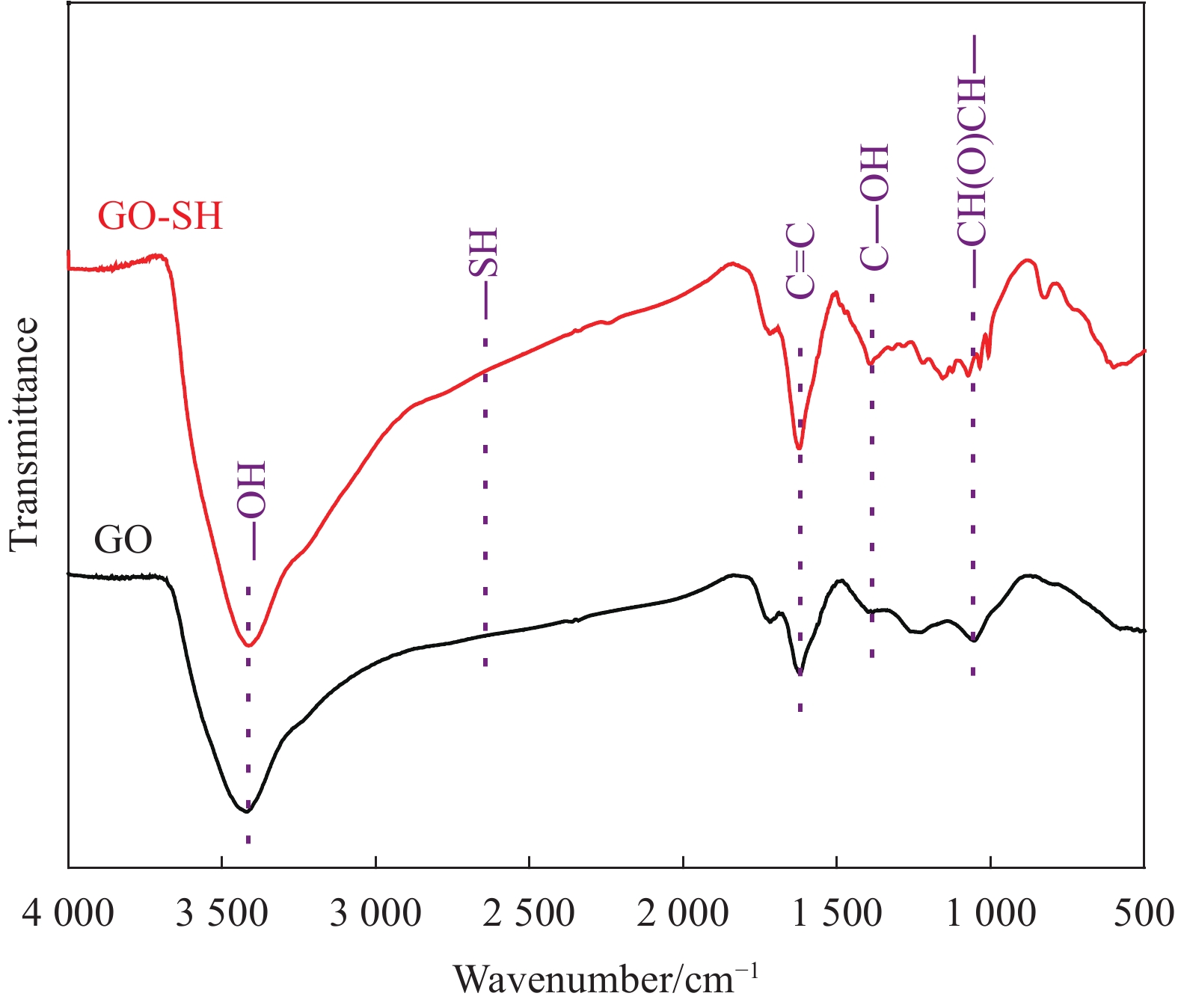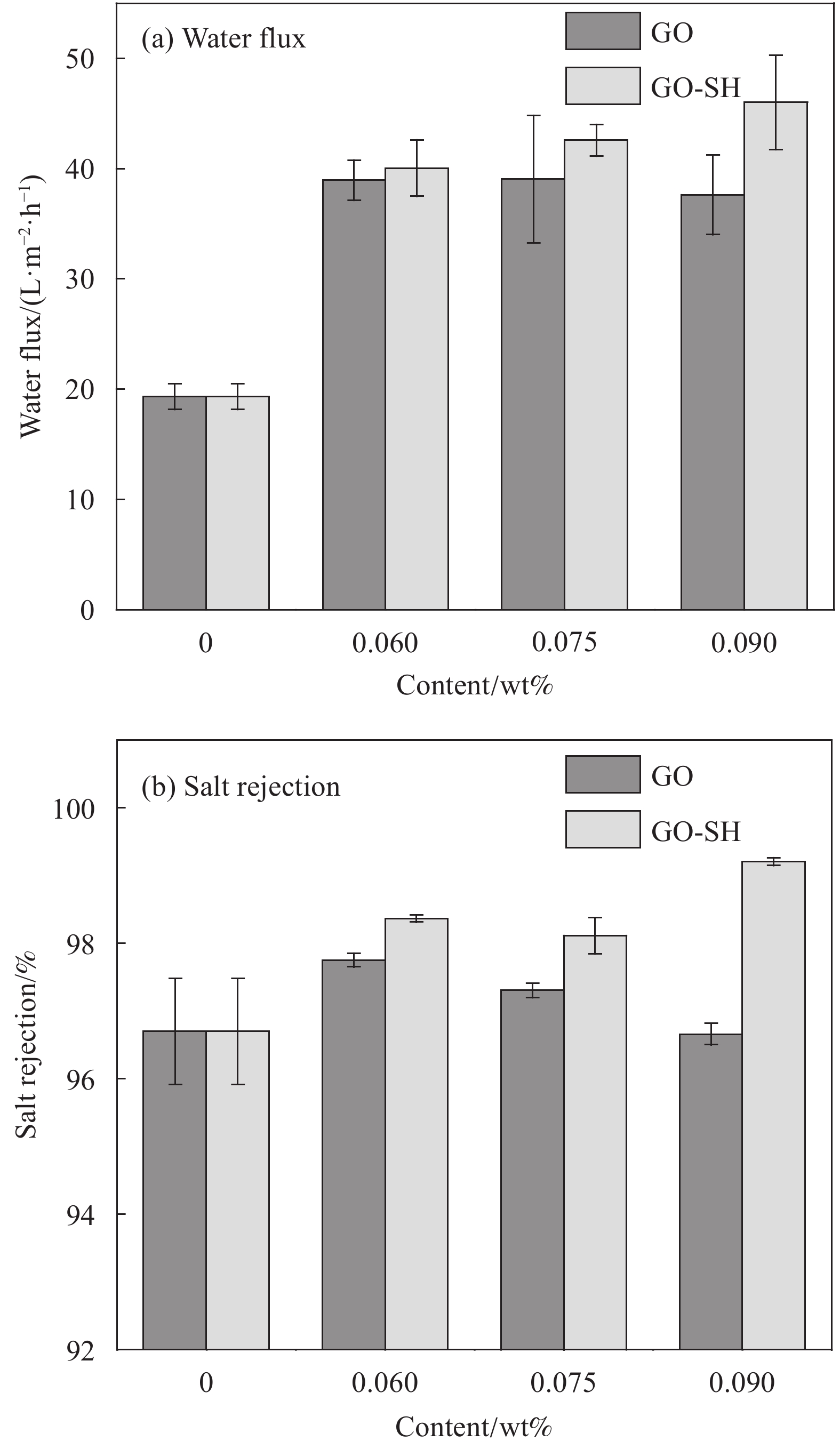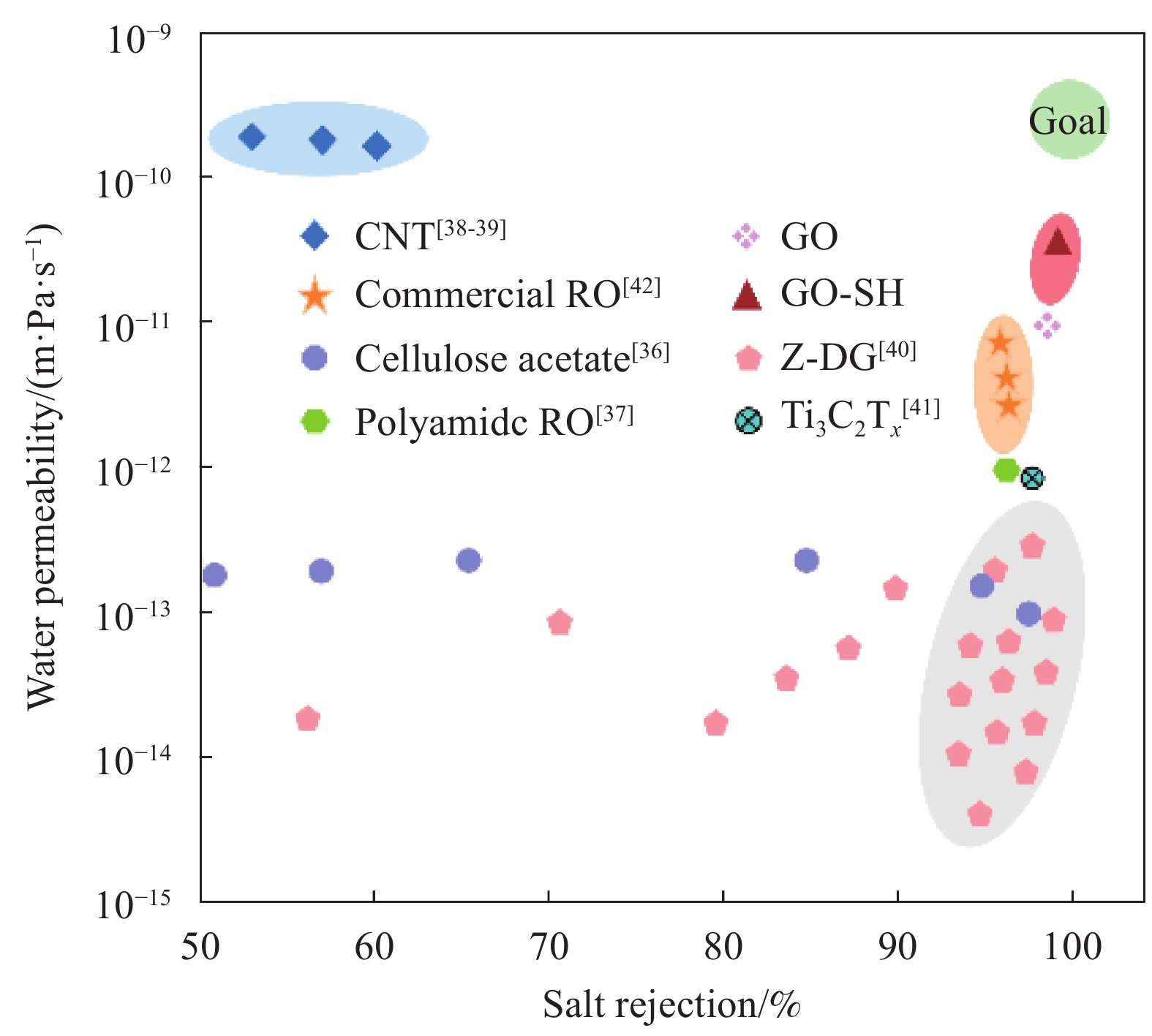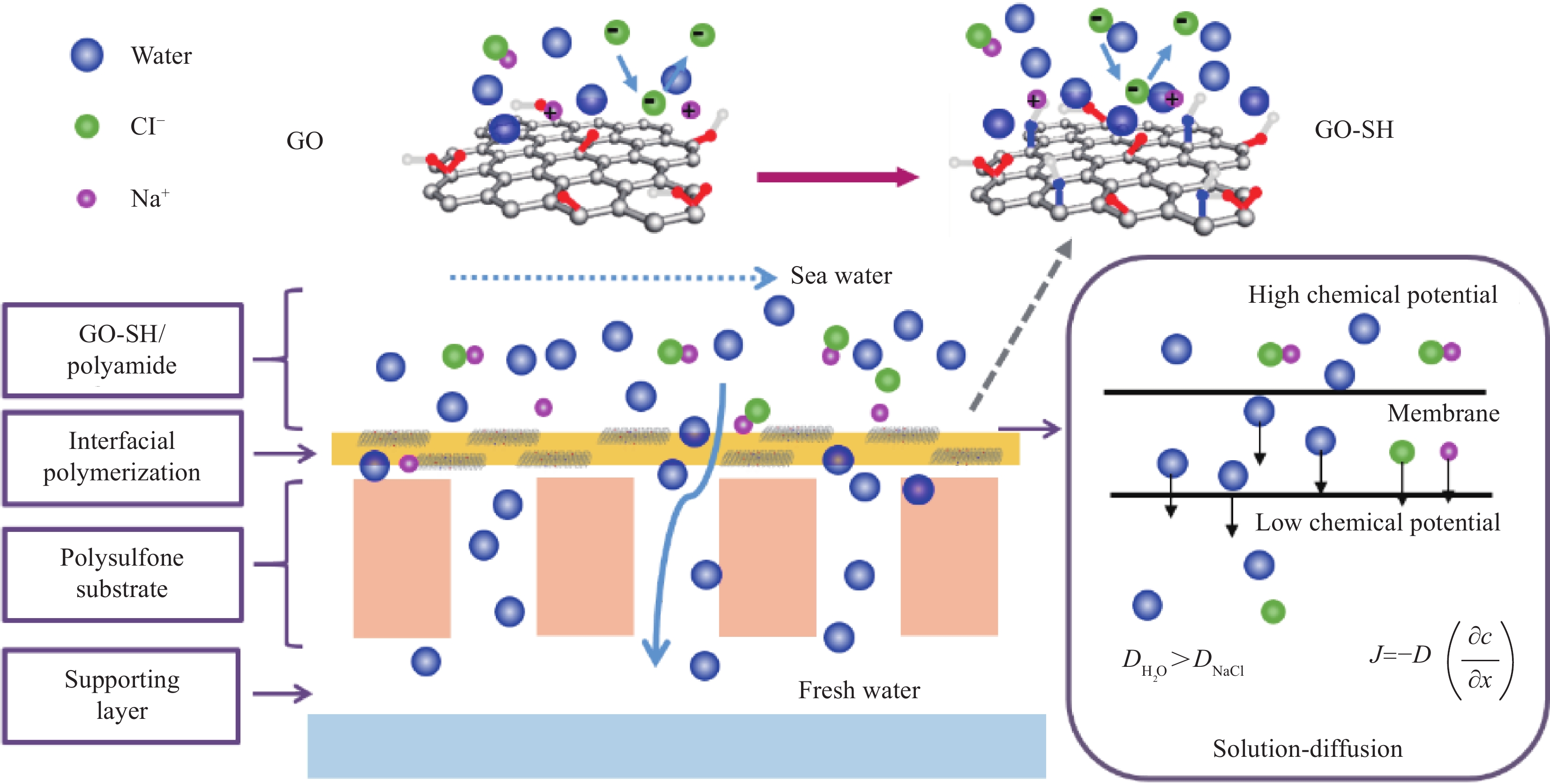Fabrication of sulfhydryl grafted graphene oxide/polyamide composite membranes for reverse osmosis desalination
-
摘要: 反渗透膜技术作为脱盐的核心技术,在海水和苦咸水淡化、超纯水制备、污水回水等领域具有广泛应用前景,但其渗透性-选择性之间的 “trade-off” 效应仍是限制反渗透技术发展的一大挑战。本研究将表面功能化(接枝巯基官能团)的氧化石墨烯(GO)掺入间苯二胺水相溶液中,通过水相间苯二胺和有机相均苯三甲酰氯界面聚合的方法制备出巯基接枝氧化石墨烯(GO-SH)/聚酰胺(PA)反渗透复合膜。利用TEM、SEM、EDS、FTIR和NMR对接枝后粉体进行表征,利用2 g·L−1 NaCl水溶液测试膜的脱盐性能,优化了界面聚合水相pH和反应时间的设定。研究结果表明,GO-SH能够更均匀地分散在PA中,优化后的pH为11,反应时间为4 min,当改性后粉体含量为0.09wt%时,复合膜水通量可达48 L·m−2·h−1,脱盐率达到99.6%,相较于本实验接枝前纳米材料复合的PA膜分别提高了30% 和2.54%。表面功能化的GO有效地解决了无机纳米粒子和有机聚合物的相容性,提高膜脱盐性能,有望进一步降低反渗透项目的运行成本。Abstract: As the core technology of desalination, reverse osmosis membrane technology has a wide application prospect in desalination of seawater and brackish water, preparation of ultra-pure water, sewage backwater and other fields. However, the “trade-off” effect between permeability and selectivity is still a major challenge to restrict the development of it. In this study, surface functionalized (grafted sulfhydryl group) graphene oxide (GO) was incorporated into m-phenylenediamine aqueous solution. Sulfhydryl grafted graphene oxide (GO-SH)/polyamide (PA) composite membranes were prepared by interfacial polymerization of m-phenylenediamine in aqueous phase and trimesoyl chloride in organic phase. TEM, SEM, EDS, FTIR and NMR were used to characterize the powder after grafting, and 2 g·L−1 NaCl solution was used to test the salt rejection property of the membrane, as well as the setting of pH and reaction time of interface polymerization aqueous phase was optimized. The results show that the GO-SH is more uniformly dispersed in the polyamide, the optimized pH is 11 and the reaction time is 4 min. When the modified powder content is 0.09wt%, composite membrane water flux can be up to 48 L·m−2·h−1 and the salt rejection reaches 99.6%, which are 30% and 2.54% higher than that of the GO/PA membrane in this study. Surface functionalized GO effectively solves the compatibility of inorganic nanoparticles and organic polymers, improves the membrane separation performance, and can be expected to further reduce the operating cost of reverse osmosis projects.
-
Keywords:
- sulfhydryl grafting /
- graphene oxide /
- reverse osmosis /
- polyamide /
- desalination
-
随着全球人口增加和产业化发展,淡水的需求逐渐增多,海水淡化已成为新世纪解决淡水资源紧缺问题的重要战略选择之一[1]。近年来,反渗透膜以其分离效率高、能耗低、易操作性及机械稳定性强等优点广泛应用于水净化、污水回水和海水淡化等领域[2-4]。到目前为止,常用反渗透膜是通过界面聚合在孔状聚砜支撑层(PSF)和无纺布纤维力学支撑层构成的基底膜顶部形成超薄聚酰胺(PA)分离活性层[5-6],其中PA活性层厚度大约只有100 nm[7]。然而,传统的PA反渗透膜在压力驱动下实现分离时,水的通量远低于商业所用的多孔膜,且PA的形貌和结构导致的渗透性和盐离子截留之间的“trade-off”效应[8-9],难以满足低的生产成本和高的能源效率要求,极大限制了反渗透膜在水处理应用中的拓展和突破。
因此,为了解决上述问题,更多的研究者强调对膜形貌或结构的调控和设计,并持续探索新材料。其中,纳米材料基于精确可控的分子组成、尺寸、结构和表面化学,在PA复合膜功能化具有许多潜在的应用[10]。二十一世纪初,Seung等[11]通过TiO2纳米粒子在聚合物链上自组装,制备出有机/无机反渗透薄膜,提高膜表面渗透性和光催化杀菌能力。自此纳米粒子掺入聚合物中制备高性能薄膜的方法逐渐进入大众视野,并且研究发现选择不同纳米粒子嵌入到膜中,如CNTs[12-13]、BN[14]、SiO2[15]、和沸石[16]等,均可以给PA带来更优异的渗透性,甚至可以提升膜表面耐污染和耐氯等性能。碳基功能纳米材料由于其独特的化学和物理性能组合,引起了科学界的广泛关注,在纳米材料科学的发展中起着关键作用。从传统的三维石墨到新的碳纳米材料,如富勒烯、碳纳米管(CNTs)、石墨烯及其应用的基础研究一直是物理、化学、材料等多学科领域的热点[10, 17]。氧化石墨烯(GO)作为石墨烯的衍生物,表面具有丰富的官能团、高的比表面积、优越的力学能力和热稳定性[18],在膜技术的发展中引起了人们的广泛关注。Xia等[19]利用GO改性PA薄膜复合膜,发现GO在其基面和边缘丰富的含氧官能团 (即羟基、羧基和环氧),使其能够与水分子形成氢网络,并在掺入时提高膜的亲水性和水通量。2016年,Yin等[20]将GO纳米片引入到PA中,从膜表面形貌结构、亲水性、粗糙度等方面进一步证明了GO在水净化薄膜中的作用。
然而,在界面聚合过程中将GO纳米材料嵌入到PA层也存在一些困难,因为亲水性纳米材料在酰氯有机相中的分散性差 (如果纳米材料被添加到非极性溶剂中) 或纳米材料在胺的水溶液中容易损失 (如果纳米材料被添加到极性溶剂中)[21-22]。同时,GO在聚合物中的掺入,使PA膜表面存在更多的缺陷,水通量大幅提升的同时,脱盐率明显下降[20]。研究发现GO是由环氧、羧基和羟基等含碳官能团组成的孤立单原子材料,这些官能团为通过改变添加剂来裁剪石墨烯的性能提供了机会[23]。巯基是一种新的类似于羟基、羧基等的亲水性官能团[24],并且它形成氢键的能力更优于羟基,当巯基功能化GO通过界面聚合过程嵌入到PA时,纳米材料能够更稳固更均匀地分散在PA中。
在本研究中,为解决GO纳米粒子在有机物中分散和膜渗透性-选择性相互制约问题,在GO表面接枝巯基官能团实现功能化(GO-SH)后在界面聚合过程掺入到PA中,制备出新的GO-SH/PA反渗透复合膜,分析膜表面形貌的改变及GO-SH对复合膜脱盐性能的影响,并对几种常见的商用膜和纳米材料引入的复合膜性能进行比较,阐述其增强机制。
1. 实验材料及方法
1.1 试剂和仪器
多孔商用聚砜(PSF)作为反渗透膜的基底膜,由南京帝膜净水技术有限公司提供。氧化石墨烯饼(GO,44.42%) 购买于常州市第六元素材料科技股份有限公司),4-氨基苯硫酚(分析纯)、三乙胺 (TEA,99%)、乙酸 (分析纯)、正己烷(97%)、NaCl (>99%)和间苯二胺(MPD,≥99.5%) 均由国药集团化学试剂有限公司提供,HCl (分析纯) 购买于上海凌峰化学试剂有限公司,亚硝酸钠(NaNO2,分析纯) 购买于西陇科学股份有限公司,均苯三甲酰氯(TMC,98%) 购买于上海阿拉丁生化科技股份有限公司,十二烷基苯磺酸钠(C12H25NaO3S,98%) 由永华化学科技有限公司提供。
采用透射电子显微镜镜 (TEM, JEM-2100,日本电子公司) 和场发射扫描电子显微镜(FESEM,HITACHI S-4800,日本日立公司)对改性粉体和膜表面微观形貌进行表征及X射线能谱仪(EDS)对膜表面的元素定量分析,采用傅里叶红外光谱仪(FTIR,Nicolet Is10,美国赛默飞公司) 表征改性前后粉体化学结构,波长扫描范围4 000~400 cm−1,分辨率为2 cm−1,扫描32次,采用核磁共振波谱仪(1H NMR, JNM-ECZ600R/S3 600M,日本电子公司) 表征改性前后粉体微观结构,频率为400 Hz,采用三联高压平板膜小试设备(FlowMem0021-HP,厦门福美科技有限公司)测试复合膜脱盐性能,采用电导率仪(雷磁DDSJ-318, 上海仪电科学仪器科技有限公司)测试溶液盐浓度。
1.2 GO-SH和GO-SH/聚酰胺(PA)复合膜制备
GO-SH的制备:取适量GO粉饼在蒸馏水中,加入适当的表面活性剂(PVP),超声分散均匀,透析3天后,超声波细胞粉碎仪超声剥离得到预处理好的GO。对氨基苯硫酚(1 mol/L)和HCl(1 mol/L)在50℃水浴锅中混合溶解,1 mol/L的NaNO2蒸馏水稀释至0.375 mol/L在冰水浴和不断搅拌的条件下,逐滴加入混合溶液,各组分摩尔比为n (对氨基苯硫酚)∶n(HCl)∶n(NaNO2) = 4∶5∶4。将适量预处理的GO充分溶解在蒸馏水后,滴加到上述改性溶液中,冰浴条件下连续搅拌12 h,将得到的反应物过滤,离心洗涤后透析一个星期得到GO-SH粉末,GO改性接枝机制如图1所示。
GO-SH/PA复合膜的制备:复合膜的制备采用界面聚合的方法,如图2所示。首先将PSF底膜浸泡在0.2wt%的NaCO3溶液中1 h除去表面的油污,然后依次在MPD (2.0wt/v%)、C12H25NaO3S(0.1wt/v%)、TEA (4.2 v/v%)水相溶液和1.0wt/v%TMC油相溶液中浸泡后,在60℃下加热处理,冷却至室温后保存在蒸馏水中用于后续测试。本研究分别选用浓度为0.06、0.075、0.09wt/v%的GO—SH粉末分散在MPD水相溶液中,选择相同浓度GO进行对比,并研究了乙酸调节的不同水相pH大小(8~12)和水相反应时间(3~7 min)对膜脱盐性能的影响,油相反应时间为1 min,热处理时间为5 min。
1.3 复合膜脱盐性能测试
采用如图3所示的三联高压平板膜小试设备测试反渗透复合膜的脱盐性能。测试膜池为横向错流形式(Cross-flow),进料液为浓度2 g·L−1的NaCl溶液,进水压力为1.6 MPa,控制进水流量。测试时先将膜在装置中预运行2~3 h使其压实稳定,然后用三角烧瓶收集0.5 h后的渗透液,根据下式换算成水通量:
J=VS·Δt (1) 利用电导率仪测量进料液和渗透液中盐浓度,根据下式计算脱盐率:
R=Cf−CpCf×100% (2) 式中:J为膜的水通量(L·m−2·h−1);Δt为渗透时间(h);S为膜的有效面积(m2);V为透过液的体积(L);R为膜的脱盐率;Cf为
进料液中的盐浓度(mg·L−1);Cp为渗透液中的盐浓度(mg·L−1)。实验过程中一次测试3张同样条件反渗透膜的脱盐性能,结果取平均值减少实验误差。 对比不同纳米技术对反渗透膜在脱盐性能上的影响,为避免不同压力对通量的影响,根据下式将水通量转化为透水性进行对比:
A=JΔp−Δπ (3) Δπ=ΔCs×Rg×T (4) 式中:
A 为膜的透水性 (m/(Pa·s));Δp 为跨膜的压差(MPa);Δπ 为跨膜的渗透压差(MPa);ΔCs 为进料液和渗透液盐浓度差(ΔCs=Cf−Cp );Rg 为气体常数(8.31 cm3·MPa·mol−1·K−1);T 为温度(K)。2. 结果与讨论
2.1 GO-SH微观表征
图4是GO和GO-SH粉体的TEM图像、SEM图像及EDS元素分析图谱。图4(a)和图4(b)分别为GO和GO-SH的TEM图像。可以发现超声剥离后的GO为单层片状结构,改性后的GO褶皱程度变大,片层变得更薄。图4(c)和图4(d)的SEM图像表现出改性前后的GO均保留层状结构和大的比表面积,改性后的GO表面更加平整。从图4(e)和图4(f)的EDS元素面扫分析可以发现,GO中含有C、O、Cl、W和Ca元素,而GO-SH中含有C、O、Na、S元素,这表明S元素已经成功接枝到GO表面。
图5为GO改性前后的FTIR图谱。可看出GO和GO-SH的FTIR曲线比较相似,在3 432 cm−1、1 700 cm−1、1 432 cm−1、1 134 cm−1、1 054 cm−1处均有明显的吸收峰,这些峰依次主要为—OH、芳香环上的C=C、C—OH、C—O—C和环氧基的特征吸收峰[25-26],这些特征峰说明GO-SH依然保留GO多种含氧官能团的特点。从图5还可以看出,特有官能团—SH在2 600 cm−1~2 500 cm−1范围出现较微弱的特征峰[27],这是由于—OH的吸收峰强烈,—SH的特征峰被覆盖而不被明显检测,但在图6的核磁共振氢谱分析可以发现,图6(a)中GO在0~2 ppm处的峰为芳香族和烯烃的C—H的信号[28]及化学键O—H的信号,图6(b)改性后GO可能由于芳香C—H的减少,新官能团的引入,在3~9 ppm处峰强度强烈增加,这表明该处峰为S—H在GO上的标志。综合SEM、FTIR和1H NMR分析,巯基已成功接枝到GO表面。
2.2 GO-SH/PA膜表面微观形貌
图7是原始PA膜和改性前后GO/PA复合膜的SEM图像。图7(a)、图7(b)是原始PA膜的SEM图像。可以看出PA在PSF膜上不平整的致密覆盖,呈现出几乎无孔的、粗糙的典型“峰谷”结构[29];图7(c)、图7(d)是0.06wt%GO/PA复合膜的SEM图像。GO的添加使其所制备的PA反渗透膜表面形貌出现了一些差异,叶片状PA结构变大且更圆滑,低倍率电镜的图像可以明显看到由于GO在水相溶液中的分散不均使GO成少量团聚状态覆盖在膜表面;而0.06wt%GO-SH/PA反渗透复合膜表面呈现出更尖锐的“峰和谷”的结构 (图7(e)、图7(f)),更接近于枯树叶形貌,表面的褶皱程度相对于复合前有所增加,有利于提高膜表面对进料液的有效接触面积进而提高通量,并且从低倍率电镜下观察也没有明显的纳米粒子团聚状形态,这表明巯基接枝的GO能够更好地分散在MPD水相溶液中,减少形成PA膜表面的缺陷。
2.3 GO-SH/PA反渗透膜脱盐性能
2.3.1 GO-SH含量对脱盐性能的影响
图8为不同含量接枝前后GO/PA膜的脱盐性能图。从图8(a)可以发现,GO和GO-SH的加入,都可以提升复合膜的水通量,但当GO的添加量 大于0.06 wt%时,水通量出现了下降趋势,并且脱盐率 (图8(b)) 也受到一致的影响效果,这可能是由于GO含量增多出现团聚,在PA中分散性变差导致的,这是在很多纳米粒子添加过程中都出现的现象[30-31]。接枝后的GO明显在PA中的相容性得到改善,开始加入微量的GO-SH (0.06wt%) 后,复合膜的纯水通量稍微增加,当GO—SH含量继续提高到达0.09wt%时,复合膜的纯水通量继续增加达到48 L·m−2·h−1 (相较于GO/PA膜提高了30%),此时复合膜的脱盐率由于GO-SH的掺入保持在99%左右(相较于GO/PA膜最高提升了2.54%)。这是由于GO-SH的出现增加了PA膜表面的亲水性,同时会在膜的表面薄层中增加一些通道,使水通量得到了很大的改善,另外,巯基的接枝改善了纳米粉末与聚合物的相容性,比原始GO在薄层中分散更均匀,有效减少PA生成过程中的缺陷,进而保证了膜的致密性和脱盐率。
2.3.2 pH对GO-SH/PA膜脱盐性能的影响
水相溶液的pH值对膜性能有深远的影响,较高的pH值可以有效地去除界面聚合的其他产物,从而产生更多的交联PA分离层[32]。图9(a)是水相溶液pH对GO-SH/PA复合膜脱盐性能的影响,随着pH的增大,脱盐率处于稳定上升的趋势,在pH为12时膜脱盐率最高,pH为11时通量最大。MPD和TMC两种单体反应生成PA的同时,会放出部分的酸[33],这些多余的酸可降低胺与酰氯的反应速度从而形成相对大的孔,膜表面致密性变差使水通量较高脱盐率较低。因此,当水相溶液呈碱性时,它可作为酸接收剂中和部分反应中放出的酸,优化膜的性能,但若碱性较弱即pH <11时中和作用不完全或碱性较强即pH很高时TMC和PA层水解,都会导致膜表面的交联度变差,脱盐性能下降。因此综合考虑水通量和脱盐率,最优化的pH值设定为11。
2.3.3 反应时间对膜脱盐性能的影响
界面聚合反应速度快,反应时间非常短,因此很难去调控界面聚合反应的程度,然而水相和油相在膜表面的反应时间对界面聚合反应也有很大影响[34]。图9(b)是水相反应时间对GO-SH/PA复合膜脱盐性能的影响。可以看出水相反应时间为4 min时,具有较高的截留率为99.2%,此时通量达到46 L·m−2·h−1,5 min时膜的水通量升高至51 L·m−2·h−1,此时膜表面的交联度高,在两相的界面处通过界面聚合反应形成的PA层规整度好,致密度高,因此通量达到最大而脱盐率下降至98.4%。当水相反应时间继续延长超过5 min时,水通量和截留率都在下降,这是由于在界面聚合过程中,随着反应时间的推移,一方面PA活性层变厚;另一方面,两相单体在界面处的扩散速度受影响,水相单体向有机相的扩散受到阻碍,很难形成完整交联的PA功能层,因此性能较差[35]。综合水通量和脱盐率考虑,最优化的水相反应时间设定为4 min。
2.3.4 反渗透脱盐性能比较
图10总结了近年来纳米技术对反渗透膜在脱盐性能上的影响,由于膜材料的进步,反渗透膜的性能在过去十年中有了显著的改善。反渗透膜最初是用醋酸纤维素制成的,醋酸纤维素膜在20世纪60年代开始商业化,但相对来说通量低,易受生物降解[36],然而现有的通过传统方法制备的聚合物反渗透膜具有低通量,同时也存在污垢和不良的耐化学性[37]。由于纳米技术的出现,新的纳米结构材料如碳纳米管 (CNTs)、沸石、石墨烯和新型MXene纳米材料Ti3C2Tx,由刚性的、尺寸选择性的孔组成,可以作为理想的膜,这种纳米结构材料可能有助于提高海水淡化系统效率和容量。CNTs可以合成1 nm或更小的非弯曲孔,然而CNTs直径太大,无法发挥作用,截留率较低[38-39],沸石具有高孔隙和高活性表面积而且大多数沸石的紧密孔分布小于水合盐离子的直径,这些晶体形成的膜有可能完全排斥盐离子,同时允许水分子渗透[40],因此Z-DG膜截留率较高但水通量很低,MXene纳米材料的引入在耐污染和耐氯方面对PA膜表面有极大的改善[41],但由于Ti3C2Tx表面亲水性官能团少于GO,在提高透水性方面低于GO纳米粒子。商业反渗透膜目前虽已经具有较好的脱盐性能,但依然具有提升的空间[42],为了获得更高水通量,本实验所添加的改性纳米粒子(GO-SH)在一定程度上提高了复合膜脱盐性能,比传统和商业的反渗透膜性能表现的更优异,因此纳米粒子的添加和改性在未来的膜发展过程中具有广大的应用前景。
2.4 GO-SH/PA反渗透复合膜渗透机制
根据以上测试分析,图11为GO-SH/PA复合膜渗透机制图。反渗透膜的渗透机制以溶解-扩散方式对水分子和盐离子进行选择,由于水分子和膜之间的亲和力等作用,水分子优先吸附/结合或溶解于膜表面,且水分子比溶质离子具有更高的扩散速率(图10),进而实现溶剂(水)和溶质(盐)分离[43]。在膜过滤过程中,表面亲水性的增加会促进水分子在膜表面的溶解,从而提高膜的透水性[44]。GO的片层间距(约1.0 nm)大于一般小分子尺寸能够传输分子,可以为水通过PA薄膜层提供额外的短路径。随着浓度的增加,更多的水通道被引入到致密的脱盐层中,导致水通量的增加,而GO浓度较高时,高浓度粒子聚集的问题使渗透率增强趋于平缓[20]。巯基接枝后的GO,保持GO原有结构的同时减少了纳米薄片在聚合物中团聚[26],在GO-SH浓度达到0.09wt%时,水透过性仍然不断增加,大大提升复合膜对水分子和盐离子的选择性。此外,GO-SH表面携带了更亲水性的基团,相较于改性前允许更多的水分子通过,在反渗透膜层面上形成更亲水性环境,保障了高的产水通量并作为隔离层而避免亲水性污染物的吸附,GO-SH分散在水中呈负电性与Cl−产生排斥作用,保证了复合膜的脱盐率。
3. 结 论
(1) 巯基接枝的氧化石墨烯(GO)(GO-SH)能够更好地分散在聚酰胺(PA)膜中。随着GO-SH添加量的增多,水的渗透性逐渐提升,通过微观形貌观察纳米颗粒也没有产生明显的团聚,当添加量达到0.09wt%时,水通量和脱盐率均达到较高的水平 (48 L·m−2·h−1和99.6%)。
(2) GO-SH/PA复合膜表现出优异于传统纳米粒子添加复合膜和商业反渗透膜的脱盐性能,且当水相溶液pH和反应时间的最佳设定分别为11和4 min时,性能达到最优。
(3) PA反渗透膜以溶解-扩散的方式将水分子和盐离子分离,GO-SH的掺入进一步提升了膜表面的亲水环境,保证脱盐的条件下,提供了更多的水分子通道,这为纳米粒子改性在膜当中的应用提供了更大的可能。
-
-
[1] PENATE B, GARCIA-RODRIGUEZ L. Current trends and future prospects in the design of seawater reverse osmosis desalination technology[J]. Desalination,2012,284:1-8. DOI: 10.1016/j.desal.2011.09.010
[2] SAFARPOUR M, KHATAEE A, VATANPOUR V. Thin film nanocomposite reverse osmosis membrane modified by reduced graphene oxide/TiO2 with improved desalination performance[J]. Journal of Membrane Science,2015,489:43-54. DOI: 10.1016/j.memsci.2015.04.010
[3] GREENLEE L F, LAWLER D F, FREEMAN B D, et al. Reverse osmosis desalination: Water sources, technology, and today's challenges[J]. Water Research,2009,43(9):2317-2348. DOI: 10.1016/j.watres.2009.03.010
[4] MCGILVERY C M, ABELLAN P, KLOSOWSKI M M, et al. Nanoscale chemical heterogeneity in aromatic polyamide membranes for reverse osmosis applications[J]. ACS Applied Materials & Interfaces,2020,12(17):19890-19902.
[5] ALBO J, HAGIWARA H, YANAGISHITA H, et al. Structural characterization of thin-film polyamide reverse osmosis membranes[J]. Industrial & Engineering Chemistry Research,2014,53(4):1442-1451.
[6] 席丹, 曹从军, 齐萨仁, 等. 超薄皮层反渗透复合膜制备技术的研究进展[J]. 化工进展, 2020:1-10. XI D, CAO C J, QI S R, et al. Progress in preparation of ultra-thin composite reverse osmosis membrane[J]. Chemical Industry and Engineering Progress,2020:1-10(in Chinese).
[7] ANTONY A, CHILCOTT T, COSTER H, et al. In situ structural and functional characterization of reverse osmosis membranes using electrical impedance spectroscopy[J]. Journal of Membrane Science,2013,425:89-97.
[8] JIMENEZ-SOLOMON M F, SONG Q L, JELFS K E, et al. Polymer nanofilms with enhanced microporosity by interfacial polymerization[J]. Nature Materials,2016,15(7):760-767. DOI: 10.1038/nmat4638
[9] 王娇娜, 尹泽芳, 李从举. 静电纺丝复合反渗透膜的改性制备与脱盐性能[J]. 高等学校化学学报, 2016, 37(2):396-402. DOI: 10.7503/cjcu20150519 WANG Q N, YIN Z F, LI C J. Preparation and desalination performance of composite reverse osmosis membrane based on electrospinning technology[J]. Chemical Journal of Chinese Universities,2016,37(2):396-402(in Chinese). DOI: 10.7503/cjcu20150519
[10] LI Z H, WANG L, LI Y, et al. Carbon-based functional nanomaterials: Preparation, properties and applications[J]. Composites Science and Technology,2019,179:10-40. DOI: 10.1016/j.compscitech.2019.04.028
[11] KWAK S Y, KIM S, HKIM S S. Hybrid organic/inorganic reverse osmosis (RO) membrane for bactericidal anti-fouling. 1. Preparation and characterization of TiO2 nanoparticle self-assembled aromatic polyamide thin-film-composite (TFC) membrane[J]. Environmental Science & Technology,2001,35(11):2388-2394.
[12] TAKEUCHI K, TAKIZAWA Y, KITAZAWA H, et al. Salt rejection behavior of carbon nanotube-polyamide nanocomposite reverse osmosis membranes in several salt solutions[J]. Desalination,2018,443:165-171. DOI: 10.1016/j.desal.2018.04.021
[13] LEE T H, LEE M Y, LEE H D, et al. Highly porous carbon nanotube/polysulfone nanocomposite supports for high-flux polyamide reverse osmosis membranes[J]. Journal of Membrane Science,2017,539:441-450. DOI: 10.1016/j.memsci.2017.06.027
[14] ABDIKHEIBARI S, LEI W W, DUMEE L F, et al. Novel thin film nanocomposite membranes decorated with few-layered boron nitride nanosheets for simultaneously enhanced water flux and organic fouling resistance[J]. Applied Surface Science,2019,488:565-577. DOI: 10.1016/j.apsusc.2019.05.217
[15] ISHII K, IKEDA A, TAKEUCHI T, et al. Silica-based RO membranes for separation of acidic solution[J]. Membranes,2019,9(8):94. DOI: 10.3390/membranes9080094
[16] DONG H, ZHAO L, ZHANG L, et al. High-flux reverse osmosis membranes incorporated with NaY zeolite nanoparticles for brackish water desalination[J]. Journal of Membrane Science,2015,476:373-383. DOI: 10.1016/j.memsci.2014.11.054
[17] LI Z Y, WANG L, LI Y, et al. Frontiers in carbon dots: Design, properties and applications[J]. Materials Chemistry Frontiers,2019,3(12):2571-2601. DOI: 10.1039/C9QM00415G
[18] ZHANG Y, CHUNG T S. Graphene oxide membranes for nanofiltration[J]. Current Opinion in Chemical Engineering,2017,16:9-15. DOI: 10.1016/j.coche.2017.03.002
[19] XIA S, YAO L J, ZHAO Y, et al. Preparation of graphene oxide modified polyamide thin film composite membranes with improved hydrophilicity for natural organic matter removal[J]. Chemical Engineering Journal,2015,280:720-727. DOI: 10.1016/j.cej.2015.06.063
[20] YIN J, ZHU G C, DENG B L. Graphene oxide (GO) enhanced polyamide (PA) thin-film nanocomposite (TFN) membrane for water purification[J]. Desalination,2016,379:93-101. DOI: 10.1016/j.desal.2015.11.001
[21] LAI G S, LAU W J, GOH P S, et al. Tailor-made thin film nanocomposite membrane incorporated with graphene oxide using novel interfacial polymerization technique for enhanced water separation[J]. Chemical Engineering Journal,2018,344:524-534. DOI: 10.1016/j.cej.2018.03.116
[22] YIN J, KIM E S, YANG J, et al. Fabrication of a novel thin-film nanocomposite (TFN) membrane containing MCM-41 silica nanoparticles (NPs) for water purification[J]. Journal of Membrane Science,2012,423:238-246.
[23] DONG L Q, FENG Y Y, WANG L, et al. Azobenzene-based solar thermal fuels: Design, properties, and applications[J]. Chemical Society Reviews,2018,47(19):7339-7368. DOI: 10.1039/C8CS00470F
[24] LI X Y, ZHOU H H, WU W Q, et al. Studies of heavy metal ion adsorption on chitosan/sulfydryl-functionalized graphene oxide composites[J]. Journal of Colloid and Interface Science,2015,448:389-397. DOI: 10.1016/j.jcis.2015.02.039
[25] MURUGAN A V, MURALIGANT H T, MANTHIRAM A. Rapid, facile microwave-solvothermal synthesis of graphene nanosheets and their polyaniline nanocomposites for energy strorage[J]. Chemistry of Materials,2009,21(21):5004-5006. DOI: 10.1021/cm902413c
[26] ZHAO D L, GAO X, CHEN S H, et al. Interaction between U(VI) with sulfhydryl groups functionalized graphene oxides investigated by batch and spectroscopic techniques[J]. Journal of Colloid and Interface Science,2018,524:129-138. DOI: 10.1016/j.jcis.2018.04.012
[27] FENG X M, HU J Q, CHEN X H, et al. Synthesis and electron transfer property of sulfhydryl-containing multi-walled carbon nanotube/gold nanoparticle heterojunctions[J]. Journal of Physics D-Applied Physics,2009,42(4):042001. DOI: 10.1088/0022-3727/42/4/042001
[28] GAO W, MAJUMDER M, ALEMANY L B, et al. Engineered graphite oxide materials for application in water purification[J]. ACS Applied Materials & Interfaces,2011,3(6):1821-1826.
[29] 谢欣, 张潇, 李蕊含, 等. 反渗透膜微结构的调控及海水脱硼性能的提升[J]. 高等学校化学学报, 2019, 40(9):2033-2040. DOI: 10.7503/cjcu20190104 XIE X, ZHANG X, LI R H, et al. Microstructure regulation of the reverse osmosis membrane to improve the boron removal performance[J]. Chemical Journal of Chinese Universities,2019,40(9):2033-2040(in Chinese). DOI: 10.7503/cjcu20190104
[30] KIM E S, DENG B L. Fabrication of polyamide thin-film nano-composite (PA-TFN) membrane with hydrophilized ordered mesoporous carbon (H-OMC) for water purifications[J]. Journal of Membrane Science,2011,375(1-2):46-54. DOI: 10.1016/j.memsci.2011.01.041
[31] 宋杰, 徐子丹, 周勇, 等. 表面改性纳米二氧化钛-芳香聚酰胺复合反渗透膜的制备与表征[J]. 水处理技术, 2013, 39(6):24-28. DOI: 10.3969/j.issn.1000-3770.2013.06.007 SONG J, XU Z D, ZHOU Y, et al. Preparation and characterization of surface-modified nano-TiO2/aromatic polyamide composite reverse osmosis membranes[J]. Technology of Water Treatment,2013,39(6):24-28(in Chinese). DOI: 10.3969/j.issn.1000-3770.2013.06.007
[32] LIU M H, YU S C, TAO J, et al. Preparation, structure characteristics and separation properties of thin-film composite polyamide-urethane seawater reverse osmosis membrane[J]. Journal of Membrane Science,2008,325(2):947-956. DOI: 10.1016/j.memsci.2008.09.033
[33] YU S C, LIU M H, LUE Z H, et al. Aromatic-cycloaliphatic polyamide thin-film composite membrane with improved chlorine resistance prepared from m-phenylenediamine-4-methyl and cyclohexane-1, 3, 5-tricarbonyl chloride[J]. Journal of Membrane Science,2009,344(1-2):155-164. DOI: 10.1016/j.memsci.2009.07.046
[34] YAN W T, SHI M Q, WANG Z, et al. Confined growth of skin layer for high performance reverse osmosis membrane[J]. Journal of Membrane Science,2019,585:208-217. DOI: 10.1016/j.memsci.2019.05.033
[35] XU J, YAN H, ZHANG Y, et al. The morphology of fully-aromatic polyamide separation layer and its relationship with separation performance of TFC membranes[J]. Journal of Membrane Science,2017,541:174-188. DOI: 10.1016/j.memsci.2017.06.057
[36] YIN C, ZHANG Y J, CHEN Z, et al. Correlation between the pore resistance and water flux of the cellulose acetate membrane[J]. Environmental Science-Water Research & Technology,2017,3(6):1037-1041.
[37] WANG X, FANG D F, HSIAO B S, et al. Nanofiltration membranes based on thin-film nanofibrous composites[J]. Journal of Membrane Science,2014,469:188-197. DOI: 10.1016/j.memsci.2014.06.049
[38] FORNASIERO F, PARK H G, HOLT J K, et al. Ion exclusion by sub-2-nm carbon nanotube pores[J]. Proceedings of the National Academy of Sciences of the United States of America,2008,105(45):17250-17255. DOI: 10.1073/pnas.0710437105
[39] HOLT J K, PARK H G, WANG Y M, et al. Fast mass transport through sub-2-nanometer carbon nanotubes[J]. Science,2006,312(5776):1034-1037. DOI: 10.1126/science.1126298
[40] LI L X, LEE R. Purification of produced water by ceramic membranes: material screening, process design and economics[J]. Separation Science and Technology,2009,44(15):3455-3484. DOI: 10.1080/01496390903253395
[41] WANG X Y, LI Q Q, ZHANG J F, et al. Novel thin-film reverse osmosis membrane with MXene Ti3C2Tx embedded in polyamide to enhance the water flux, anti-fouling and chlorine resistance for water desalination[J]. Jounal of Membrane Science,2020,603:118036. DOI: 10.1016/j.memsci.2020.118036
[42] DAVID C T, GROSSMAN J C. Water desalination across nanoporous graphene[J]. Nano Letters,2012,12(7):3602-3608. DOI: 10.1021/nl3012853
[43] GEISE G M, PAUL D R, FREEMAN B D. Fundamental water and salt transport properties of polymeric materials[J]. Progress in Polymer Science,2014,39(1):1-42. DOI: 10.1016/j.progpolymsci.2013.07.001
[44] ROH I J, GREENBERG A R, KHARE V P. Synthesis and characterization of interfacially polymerized polyamide thin films[J]. Desalination,2006,191(1-3):279-290. DOI: 10.1016/j.desal.2006.03.004
-
期刊类型引用(3)
1. 李梦涵,魏娜,徐瑞琪,杨泽钰,崔洪芝. 三维碳纳米管/硅藻土基多孔陶瓷复合材料的制备及其光热水蒸发性能. 复合材料学报. 2023(08): 4577-4586 .  本站查看
本站查看
2. 吴玉萍,王乾廷,孙炜,周忠华,谢宗丽,宋铭雨. 含椭圆叶片状SiO_2/聚乙烯醇渗透汽化复合膜的制备与性能. 复合材料学报. 2022(06): 2783-2791 .  本站查看
本站查看
3. 赵士雄. 反渗透复合膜制备及其改性方法研究进展. 云南化工. 2022(06): 20-21+38 .  百度学术
百度学术
其他类型引用(1)
-





 下载:
下载:

